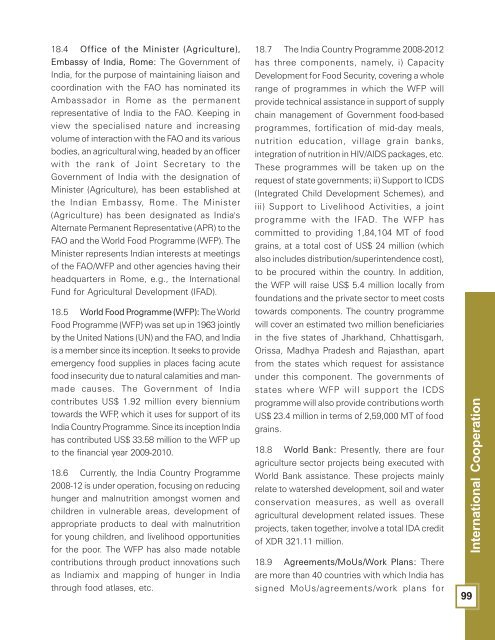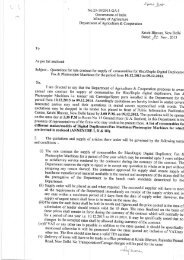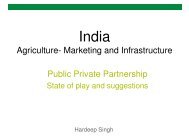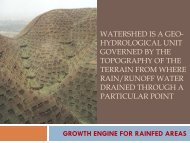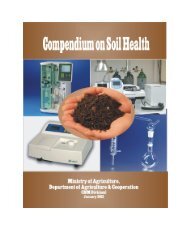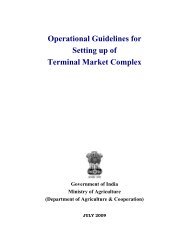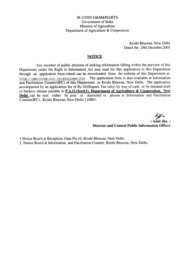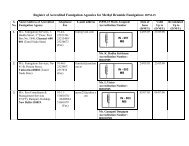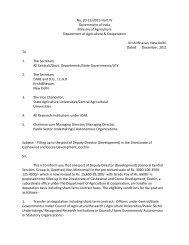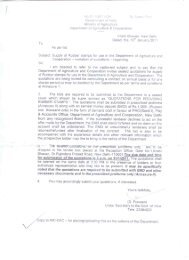Annual Report 2009-2010 - Department of Agriculture & Co-operation
Annual Report 2009-2010 - Department of Agriculture & Co-operation
Annual Report 2009-2010 - Department of Agriculture & Co-operation
Create successful ePaper yourself
Turn your PDF publications into a flip-book with our unique Google optimized e-Paper software.
18.4 Office <strong>of</strong> the Minister (<strong>Agriculture</strong>),<br />
Embassy <strong>of</strong> India, Rome: The Government <strong>of</strong><br />
India, for the purpose <strong>of</strong> maintaining liaison and<br />
coordination with the FAO has nominated its<br />
Ambassador in Rome as the permanent<br />
representative <strong>of</strong> India to the FAO. Keeping in<br />
view the specialised nature and increasing<br />
volume <strong>of</strong> interaction with the FAO and its various<br />
bodies, an agricultural wing, headed by an <strong>of</strong>ficer<br />
with the rank <strong>of</strong> Joint Secretary to the<br />
Government <strong>of</strong> India with the designation <strong>of</strong><br />
Minister (<strong>Agriculture</strong>), has been established at<br />
the Indian Embassy, Rome. The Minister<br />
(<strong>Agriculture</strong>) has been designated as India's<br />
Alternate Permanent Representative (APR) to the<br />
FAO and the World Food Programme (WFP). The<br />
Minister represents Indian interests at meetings<br />
<strong>of</strong> the FAO/WFP and other agencies having their<br />
headquarters in Rome, e.g., the International<br />
Fund for Agricultural Development (IFAD).<br />
18.5 World Food Programme (WFP): The World<br />
Food Programme (WFP) was set up in 1963 jointly<br />
by the United Nations (UN) and the FAO, and India<br />
is a member since its inception. It seeks to provide<br />
emergency food supplies in places facing acute<br />
food insecurity due to natural calamities and manmade<br />
causes. The Government <strong>of</strong> India<br />
contributes US$ 1.92 million every biennium<br />
towards the WFP, which it uses for support <strong>of</strong> its<br />
India <strong>Co</strong>untry Programme. Since its inception India<br />
has contributed US$ 33.58 million to the WFP up<br />
to the financial year <strong>2009</strong>-<strong>2010</strong>.<br />
18.6 Currently, the India <strong>Co</strong>untry Programme<br />
2008-12 is under <strong>operation</strong>, focusing on reducing<br />
hunger and malnutrition amongst women and<br />
children in vulnerable areas, development <strong>of</strong><br />
appropriate products to deal with malnutrition<br />
for young children, and livelihood opportunities<br />
for the poor. The WFP has also made notable<br />
contributions through product innovations such<br />
as Indiamix and mapping <strong>of</strong> hunger in India<br />
through food atlases, etc.<br />
18.7 The India <strong>Co</strong>untry Programme 2008-2012<br />
has three components, namely, i) Capacity<br />
Development for Food Security, covering a whole<br />
range <strong>of</strong> programmes in which the WFP will<br />
provide technical assistance in support <strong>of</strong> supply<br />
chain management <strong>of</strong> Government food-based<br />
programmes, fortification <strong>of</strong> mid-day meals,<br />
nutrition education, village grain banks,<br />
integration <strong>of</strong> nutrition in HIV/AIDS packages, etc.<br />
These programmes will be taken up on the<br />
request <strong>of</strong> state governments; ii) Support to ICDS<br />
(Integrated Child Development Schemes), and<br />
iii) Support to Livelihood Activities, a joint<br />
programme with the IFAD. The WFP has<br />
committed to providing 1,84,104 MT <strong>of</strong> food<br />
grains, at a total cost <strong>of</strong> US$ 24 million (which<br />
also includes distribution/superintendence cost),<br />
to be procured within the country. In addition,<br />
the WFP will raise US$ 5.4 million locally from<br />
foundations and the private sector to meet costs<br />
towards components. The country programme<br />
will cover an estimated two million beneficiaries<br />
in the five states <strong>of</strong> Jharkhand, Chhattisgarh,<br />
Orissa, Madhya Pradesh and Rajasthan, apart<br />
from the states which request for assistance<br />
under this component. The governments <strong>of</strong><br />
states where WFP will support the ICDS<br />
programme will also provide contributions worth<br />
US$ 23.4 million in terms <strong>of</strong> 2,59,000 MT <strong>of</strong> food<br />
grains.<br />
18.8 World Bank: Presently, there are four<br />
agriculture sector projects being executed with<br />
World Bank assistance. These projects mainly<br />
relate to watershed development, soil and water<br />
conservation measures, as well as overall<br />
agricultural development related issues. These<br />
projects, taken together, involve a total IDA credit<br />
<strong>of</strong> XDR 321.11 million.<br />
18.9 Agreements/MoUs/Work Plans: There<br />
are more than 40 countries with which India has<br />
signed MoUs/agreements/work plans for<br />
International <strong>Co</strong><strong>operation</strong><br />
99


